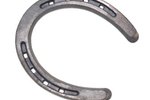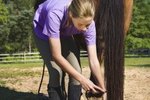
Your horse's hooves are intricate and sensitive pieces of his anatomy. Improper hoof care, bad nutrition, poor ground quality and a genetic predisposition to hoof problems can all cause your horse to become lame. Lameness can be a very serious problem for a horse. Understanding how to look for early warning signs of hoof problems can help you treat the problems before the horse goes lame or the lameness turns into a serious, permanent issue that requires significant veterinary care.
Understanding Hoof Rot
Hoof rot is a catch all term for a fungal or bacterial infection in the hoof. Hoof rot may also be called scratches or greasy heel. Thrush is also a type of hoof rot. Hoof rot can be caused by an assortment of bacteria and conditions, but the end result is that the hoof tissue becomes infected. Hoof rot can deteriorate the hoof, cause lameness and even seriously damage the structure of the hoof if it is allowed to go untreated for a long period of time.
Your Horse's Environment
Before your horse ever shows the first physical symptom of hoof rot, an educated horse person may be able to pick out problems that will ultimately lead to the development of hoof rot. If your horse is standing in mud, muck, feces, urine or otherwise wet and bacteria-filled ground, hoof rot is going to develop eventually. Muddy, wet ground weakens the hoof and provides an ideal environment for bacterial infections to develop. White markings on the legs and white hooves are also an indicator of a weaker hoof, and horses with white hooves and legs are often more likely to develop problems then those with darker legs. Weak feet, either due to color, genetics or nutrition, are another warning sign that hoof problems may be in your future. If your horse has sensitive hooves that are easily cracked, chipped or otherwise damaged, he may be at risk. Failing to clean your horse's hooves regularly puts him at an even higher risk of hoof rot.
Early Signs of Hoof Rot
A foul smell is commonly associated with hoof rot in all its various forms. If you notice that your horse's hoof smells bad when you are cleaning it out, chances are he has some type of hoof rot beginning to occur. Increased sensitivity when you are touching the hoof or cleaning it may also be a sign of a problem. Since some forms of hoof rot can occur inside the hoof, look for leg swelling, soreness, any type of discharge or heat from the hoof as well.
Lameness
In most cases, horses who develop hoof rot will go lame to some degree. Lameness may vary from a slight tenderness to full on limping or refusing to put weight on the affected limbs. If your horse goes lame and you suspect hoof rot may be the cause, call your farrier and have her check his feet. Your farrier can also prescribe a treatment for your horse to get rid of the hoof rot.
References
- Your Horse: Why Does a Horse Have a Frog, and Is The Shape Important? [] [] []
- Arizona Horse Pages: Care of Your Horse's Feet
- Penzance Progressive Natural Hoofcare: Parts of the Hoof
- California Thoroughbred Breeders Association: Hoof Care Foul Foot: Thrush and Canker
- EquiSearch: Homemade Horse Care Remedies
Photo Credits
-
BananaStock/BananaStock/Getty Images
Writer Bio
Jen Davis has been writing since 2004. She has served as a newspaper reporter and her freelance articles have appeared in magazines such as "Horses Incorporated," "The Paisley Pony" and "Alabama Living." Davis earned her Bachelor of Arts in communication with a concentration in journalism from Berry College in Rome, Ga.



